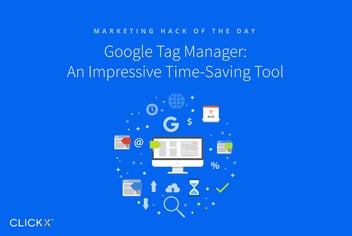Google Analytics 101: An Introduction To Setting Up

[This is a transcription from the Clickx Marketing Hack of the Day video series.]
Hey everyone! I’m Solomon with Clickx. For today’s Marketing Hack of the Day, I want to talk about Google Analytics! It’s really a 101 course for today’s video, because I love Google Analytics. I’ve been obsessed with it since day one, everything since I started doing this stuff that I’m talking about and I love it, because you can track all of your marketing in one place, it’s free and everybody should use it and there’s no reason why you’re not using it and I want to help you get set up. This is very basic, 101 stuff that I’m covering but it’ll help you get it up and running. Let’s get started!
Getting It Set Up
The first thing you want to do when you’re thinking about Google Analytics is, “Is my Google Analytics set up properly?”
And that’s a good question! That’s what people used to say, there is an advanced setup, it’s just basic setup, if you wanted to get it setup, you never done this before; you want to go to google.com/analytics! Go register your web property, it’ll give you an ID, it’ll give you a JavaScript code. If you know how to put that in yourself, you would simply go and putting the template file. If you don’t want to do that, work with a developer, someone who is technical who can add it to a template, right! You put that in every single page of your website and I mean every single page.
Once you have added the code of Google Analytics on every single page of your website, it is going to begin to track the traffic and all the activities in the bounce rate that is happening on your website. After that what you want to do is, setup goals, you’re asking yourself what the heck is a goal! Well! I told you this on beginners course, so I’m going to give you that right now! Goals it’s really reverse engineering the conversions that are happening! You want to understand who are converting, on what page they’re converting; you’re going to use those goals to set up your online sales. If you are an e-commerce company, you want to go, track the conversions from a contact forum; you want to get a free sample I mentioned or newsletter signup, you could even track an actual phone call correct! If somebody calls you, can track that as a goal.
Creating A Goal
In order to set up a goal, you simply go to the goal section, you go to the admin section, you setup a goal and you put a name for your goal and it’s going to also ask you for a thank you, URL! So you put the little URL that you want to track, maybe it’s like /thank you.html or /thank you and you could actually put a value for every goal that you want to track! If you want to track an email newsletter as ten dollars or if you want to track a contact us form as 50 bucks, if you’re a lawyer it might be worth two thousand dollars; so I don’t really know what it is for your business, but you want to put a reasonable value for every single goal! So that you can actually run some analysis on how much of this is work to your business! Using a custom URL builder, you’re able to set up the source, the medium, the term, the content all these things that you’re going to need to track every single one of your campaigns; whether they’re offline or online campaigns!
You might be thinking, “Solomon, did you just say offline campaigns? You’re telling me, I could track offline campaigns?” The answer is yes! You can definitely track offline campaigns and you should track offline campaigns, because Google Analytics, my friend, you can track everything.
And the way that you would track an offline marketing campaign is to go to the URL builder and create a custom URL for that offline campaign. So you want to know that your source, let’s say, it’s radio and you want to know that it is such-and-such ad, so you’re going to put the sources, in the medium and in the term, because you had a specific offer; so you’re going to put all these things into your custom URL builder.
Using Tracking URLs
Once that’s done, you’re going to create a domain name. First you can buy a domain name, then you’re going to make it forward to this custom URL and by doing that you’re actually going to be able to generate so much more information about that offline campaign that you ran, even if it’s a direct mail campaign it’s a radio ad it could be TV all these things can be tracked just by creating a custom URL.
So, I mentioned the vanity URL. If you have never sort of bought a domain name and make it forward to it just so you can track, I would highly recommend you do it. You know we have a tool here called Clickx Grader and what that does is; it grades any domain name you put in there, you can put in your website actually grades your organic presence, your title tag, your meta description whether you’re using social media or not and whether you’re using paid media or not, who are your competitors, your most prominent backlinks and all these things is there! And we wanted to track that, if we were to do a direct mail campaign or if we were to do a radio ad, so basically we would just buy Clickx grader.com and you would just forward to this custom URL and that is going to give us so much insight into where this traffic came from and even how many people convert it in later on as a customer. Alright? So, you’ve done it, you got the basics, you probably got your goal setup and you’re thinking about they all find tracking; it’s like dude, my heads going to blow up, but you’re not done yet!
Again, in Google Analytics 101, I want to tell you, which report you should consider, What should you look at! Let’s just say, fast-forward you got a month worth of data you’re like I’m in, I need to look at the stuff, what do you want me to look at?
Metrics You Should Analyze
The first and foremost thing and I’m telling you what people are doing, right! It’s not maybe the first thing that we’ll look at, but most of the time they want to know, tell me about all my traffic, tell me what am I getting on my traffic from, I want to know what are all the channels give me the social media breakdown vs organic versus direct versus referral.
So in order to do that, you go into Google Analytics, you click on acquisition, there’s a button for all traffic; then you click on channels and you will start to see your high level overview of all your visits!
Now, what I want to get too much like I said, I’m trying to keep it very basic, but this will show you all the different channels that is giving your traffic from your organic, from your paid, from your social media stuff. If you’re doing email marketing, all these things are going to be there! Now, it’s a pretty good way to assess what’s working, where do you get most of your traffic from, again, take a look at the referral; you can drill down and see where you’re getting your referral traffic from, right! You want to go as deep as possible which site exactly is giving you all the traffic that’s really important!
Now, another thing that you can look at is the top landing pages. Because to me, it’s really effective to know what are my top pages, so I really want to work on maybe improving them, maybe adding call to actions to them. So, you would go to behavior, site content, landing pages, again, to learn, but two levels deep, not very complicated.
And what you can do here is you can actually add another segment of traffic where you can see which one or your marketing channels are bringing traffic to the specific landing pages and you can start to look at the behavior of those visitors, how long they stay on the website, what is the bounce rate all these things are really important to measure, because you need to be working on improving all this metrics that you’re looking at on this page!
Again, these are really important. You should look at the traffic acquisition report and you want to look at the keyword analysis report.
That’s one thing when we do the integration with Clickx! We look at this very deeply, because we want to understand every single possible keyword that people are using to come to our website!
Wrapping it Up
Now, one of the important things that I would also look at is how many people are coming to your website for the first time and how many people come back over-and-over! And in order to do that, you want to go to audience behavior, new versus returning. If you click on that button, you’re actually able to see what percentage of people are coming for the second time, third time, fourth time and what percentage of people are just new for the first time!
So, I hope you got some insights into how you can set up your Google Analytics and how you can get it setup you know, start tracking some high level information and get your goal setup and maybe play around with the URL builder! All these are very basic stuff you want to be having in place before you can actually do anything advance and I’ll definitely make more videos around all these topics that we touched on today and I hope you got some insights!
Thank you again for watching another edition of Marketing Hack of the Day.



